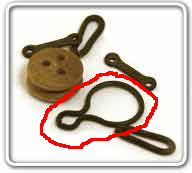-
Posts
5,662 -
Joined
-
Last visited
Content Type
Profiles
Forums
Gallery
Events
Everything posted by Jack12477
-
Can't open the attached PDF file - get a message it is not available "to your account". Is this a protected file? What's the issue with mansonia? Health issue? or ??? I've built a lot of Artesania Latina kits over the years and never encountered any obvious issues with any wood they supplied. But then I'm not sure which kits contained mansonia and which did not.
-
Chuck is there any way with this new feature to force a "Confirm Delete" pop-up if the member accidentally (or on purpose) deletes a topic. It would ONLY have to apply to topic deletes not post deletes.? If the member had to "press Delete" twice, it might stop some of the accidental deletes. Once the "Confirm Delete" is pressed then it's bye-bye topic and it goes into this new trash can you described.
-
Nice model, Derek, and great photos as well. Wish I had studio lights like yours. I was more the outdoors photographer than studio so never infested in them.
- 134 replies
-
- artesania latina
- mare nostrum
-
(and 1 more)
Tagged with:
-
I agree with Per, very nice setup. BTW, I gave up on ME line a long time ago and switched to Chuck's line (Syren), much much better.
- 165 replies
-
- finished
- model shipways
-
(and 1 more)
Tagged with:
-
I second Ken's, Per's and Sjors' remarks. Great job, Bug, you did Augie proud. Thanks!
- 2,191 replies
-
- confederacy
- Model Shipways
-
(and 1 more)
Tagged with:
-

Airbrush
Jack12477 replied to Mike Dowling's topic in Painting, finishing and weathering products and techniques
Very impressive models and magazine covers, James. -
Very nice, Marc. Decals look great. Finish on the boat is clean, crisp. Excellent job. Your sister will enjoy it.
- 165 replies
-
- cape cod catboat
- Finished
-
(and 1 more)
Tagged with:
-
Just catching up with your build. Beautiful stand, Steve. Very nice presentation.
- 165 replies
-
- finished
- model shipways
-
(and 1 more)
Tagged with:
-

Model Shipway's Paints
Jack12477 replied to Worldway's topic in Painting, finishing and weathering products and techniques
Do you ever do your own research ? Or do you expect us to do it for you? ModelExpo - Vallejo paints Hobby Lobby - Vallejo paints -
When you load the photos in using the Choose Files function, they load somewhat randomly. To get them added to the post in the order you want, just click the + (plus sign) symbol in the photo preview, click each photo in the order you want and wait for the system to add it before clicking on the next one. I just added photos to my Skipjack build without any problem.
-
Small Update/Progress Report: I installed the shrouds around the main mast and lashed the deadeyes in place. Had a lot of trouble with the deadeye rings supplied by MS - they spread open too easily and pull out of the chainplates. Spent a lot of time using medium CA getting the "glued" back into the chainplate. They are the ones circled in red in the last photo below.
- 250 replies
-
- willie l bennett
- model shipways
-
(and 1 more)
Tagged with:
-
Bug, are you using Chuck's Longboat kit to make these boats ?
- 2,191 replies
-
- confederacy
- Model Shipways
-
(and 1 more)
Tagged with:
-

Model Shipway's Paints
Jack12477 replied to Worldway's topic in Painting, finishing and weathering products and techniques
Vallejo makes a paint specifically formulated for airbrushing straight from the bottle - no mixing or dilution required. They also make a formulation for applying with a brush. Both are available from Hobby Lobby or Micro-Mark (in NJ) mail order. -

Model Shipway's Paints
Jack12477 replied to Worldway's topic in Painting, finishing and weathering products and techniques
Did you read Brian's (GuntherMT) post above ? He answered your question. -
Nasty stuff Denis. My Admiral had that and came down with a bad C.Diff infection that landed her in hospital for a week. Keep on the probiotics for at least 2 months to be safe.
-
Just checking to see if everything is still viewable. Still working on the Lazy Jacks and other rigging
- 250 replies
-
- willie l bennett
- model shipways
-
(and 1 more)
Tagged with:
About us
Modelshipworld - Advancing Ship Modeling through Research
SSL Secured
Your security is important for us so this Website is SSL-Secured
NRG Mailing Address
Nautical Research Guild
237 South Lincoln Street
Westmont IL, 60559-1917
Model Ship World ® and the MSW logo are Registered Trademarks, and belong to the Nautical Research Guild (United States Patent and Trademark Office: No. 6,929,264 & No. 6,929,274, registered Dec. 20, 2022)
Helpful Links
About the NRG
If you enjoy building ship models that are historically accurate as well as beautiful, then The Nautical Research Guild (NRG) is just right for you.
The Guild is a non-profit educational organization whose mission is to “Advance Ship Modeling Through Research”. We provide support to our members in their efforts to raise the quality of their model ships.
The Nautical Research Guild has published our world-renowned quarterly magazine, The Nautical Research Journal, since 1955. The pages of the Journal are full of articles by accomplished ship modelers who show you how they create those exquisite details on their models, and by maritime historians who show you the correct details to build. The Journal is available in both print and digital editions. Go to the NRG web site (www.thenrg.org) to download a complimentary digital copy of the Journal. The NRG also publishes plan sets, books and compilations of back issues of the Journal and the former Ships in Scale and Model Ship Builder magazines.


